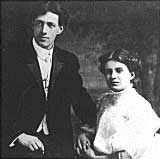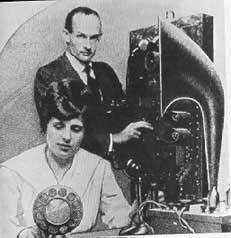Aimee Semple McPherson
|
|
AimeeSempleMcPherson.jpeg
Photograph of McPherson
Aimee Semple McPherson (1890-1944)
Aimee Semple McPherson (October 9, 1890 – September 27, 1944), also known as "Sister Aimee" or simply "Sister," was an evangelist and media sensation in the 1920s and 1930s, founder of the Foursquare Church.
| Contents |
Early life
Born Aimee Elizabeth Kennedy in Salford, Ontario, Canada she was the daughter of James Morgan Kennedy, a widower and devout Methodist, and Mildred Ona Pearce, 36 years his junior, who had been hired to nurse his wife during her terminal illness. (The age difference had caused a scandal in their small town, prompting the couple to elope to Michigan.)
Her mother had been orphaned at an early age, and raised by a couple who worked with the Salvation Army. As a result, Aimee was raised in an atmosphere of strong Christian beliefs. As a teenager, however, she became an avowed atheist, and began her public speaking career at the age of 13 in this context, writing letters to the newspaper defending evolution, debating local clergy, etc.
She met her first husband Robert James Semple, a Pentecostal missionary from Ireland, in December 1907 while attending a revival meeting at the urging of her father. After her conversion and a short courtship, they were married on August 12, 1908. Shortly thereafter, the two embarked on an evangelical tour, first to Europe and then to China, where they arrived in June, 1910. Shortly after they disembarked in Hong Kong, however, they both contracted malaria. Robert Semple died of the disease on August 19, 1910. Aimee recovered and gave birth to a daughter, Roberta Star Semple, on September 17, after which she returned to the United States.
Her mother "Minnie" had, in the footsteps of her foster parents, remained active with the Salvation Army, and after a short recuperation Aimee joined her in this work. While so occupied in New York, she met her second husband, Harold Stewart McPherson, an accountant. They were married on May 5, 1912, and they had a son, Rolf Potter Kennedy McPherson, born March 23, 1913.
Evangelism and Foursquare Gospel
After the birth of her son, McPherson suffered from postpartum depression and several serious health issues. After what she described as a near-death experience in 1913, she embarked upon a preaching career in Canada and the U.S. By June 1915 she had left home and was on the road preaching full-time.
In 1916 she made a tour through the southern U.S. in her "Gospel Car," a 1912 Packard touring car with religious slogans painted on the side; standing in the back seat of the convertible, she would give sermons through a bullhorn. On the road between sermons, she would sit in the back seat typing sermons and other religious materials. By 1917 she had started her own newspaper, named The Bridal Call, for which she wrote many of the articles.
Although her husband initially made efforts to join her on her religious travels, he soon became frustrated with the situation, and by 1918 had filed for separation. His petition for divorce, citing abandonment, was granted in 1921.
Aimee McPherson spent the four years of 1918 to 1922 as itinerant Pentecostal preacher, finally settling with her mother in Los Angeles, California and founding the Foursquare Gospel church. She supervised construction of a large, domed church building in the Echo Park area of Los Angeles, and it was completed in June 1923. Named Angelus Temple, it had a seating capacity of over 5,000.
At the time, women in the pulpit ministry were rare—those who wore makeup and jewelry in the pulpit, nonexistent. McPherson's uniqueness in this respect, her flamboyance and her unashamed use of low-key sex appeal to attract converts, endeared her to her crowd of followers in Los Angeles. She would invariably appear before parishioners in a white gown, carrying a bouquet of flowers.
Since Pentecostalism was not popular in the U.S. during the '20s she avoided the label, but she was heavily influenced by this faith, incorporating demonstrations of speaking-in-tongues and faith healing into her sermons, and keeping a museum of crutches, wheelchairs and so forth as demonstrations of her "success." She was also strongly influenced by the Salvation Army: in a campaign to spread the church nationwide, she adopted a theme of "lighthouses" for the satellite churches, referring to the parent church as the "Salvation Navy."
Unlike her contemporary Billy Sunday, McPherson was less a fire-and-brimstone preacher than one to endorse charitable work and "ecstatic" facets of worship. These traits also increased her popularity.
Always seeking publicity in the name of gaining converts, McPherson continued publishing with the weekly Foursquare Crusader and a monthly magazine dubbed Bible Call. She also began broadcasting on radio in its infancy of the early '20s. McPherson was first woman in history to preach a radio sermon, and with the opening of Foursquare Gospel-owned KFSG on February 6, 1924, she also became the first woman to be granted a broadcast license by the Federal Communications Commission.
McPherson made the most of the show-business atmosphere of Los Angeles to incorporate entertainment into her religious meetings, using stage props, contemporary music, and morality plays (which she called "illustrations"), with elaborate costumes and scenery, to their best advantage to draw listeners. She even wrote and produced a couple of operas, and at one meeting made a dramatic entrance riding a motorcycle down the aisle of Angelus Temple.
She was also very skillful at fundraising. Collections were taken at every meeting, usually with the admonishment of "no coins, please." When the $1.5 million Angelus Temple opened its doors, construction was already entirely paid for through private donations.
McPherson was not universally loved. For example, a group of Ku Klux Klan members once attended one of her meetings expecting a blessing, and were instead rebuked by McPherson for their racism. She also gained the animosity of several government officials and organized crime figures, as a result of the "naming names" which often occurred on her radio shows.
In 1925, the license for KFSG was suspended by the Commerce Department for deviating from its assigned frequency. Many broadcast histories claim McPherson sent an angry telegram to then-Commerce Secretary Herbert Hoover ordering his "minions of Satan" to release her station at once. This may be an urban legend.
McPherson also received several death threats in 1925, and a plot to kidnap her was foiled in September of that year, thus setting the stage for the episode for which she is best known.
"Kidnapping"
On May 18, 1926, McPherson went to Venice Beach with her secretary, to go swimming. Soon after arrival, McPherson disappeared.
It was generally assumed at the time that she had drowned; mourners crowded Venice Beach, and the commotion sparked a days-long media coverage of the event, fueled in part by William Randolph Hearst's Examiner, and even including a poem by Upton Sinclair commemorating the "tragedy." Daily updates appeared in newspapers across the country; parishioners held day-and-night seaside vigils. A futile search for the body resulted in one parishioner drowning, and another diver dying from exposure.
At about the same time, Kenneth G. Ormiston, engineer for KFSG, also disappeared. The two incidents were seen as unrelated.
About a month after the disappearance, McPherson's mother, Minnie Kennedy, received a ransom note, signed by "The Avengers," which demanded a half million dollars to ensure kidnappers would not sell McPherson into "white slavery." Kennedy later said she tossed the letter away, believing her daughter to be dead.
After 32 days (on June 23), McPherson stumbled out of the desert in Agua Prieta, Mexico, just across the border from Douglas, Arizona. She claimed that she had been kidnapped, drugged, tortured, and held for ransom in a shack in Mexico, then had escaped and walked through the desert for about 13 hours to freedom.
Several problems were found with McPherson's story. Her shoes showed no evidence of a 13-hour walk; indeed, they had grass stains on them after a supposed walk through the desert. The shack could not be found. McPherson showed up fully dressed while having disappeared wearing a bathing suit, and was wearing a watch given to her by her mother, which she had not taken on her swimming trip.
A grand jury convened on July 8 to investigate the matter, but adjourned 12 days later citing lack of evidence to proceed. However, several witnesses then came forward stating that they had seen McPherson and Ormiston at various hotels over the 32-day period.
The grand jury re-convened on August 3 and received further testimony, corroborated by documents from hotels in McPherson's handwriting. McPherson steadfastly stuck to her story that she was approached by a young couple at the beach who had asked her to come over and pray for their sick child, and that she was then shoved into a car and drugged with chloroform. However, when she was not forthcoming with answers regarding her relationship with Ormiston (who was recently estranged from his wife), Judge Samuel Blake charged McPherson and her mother with obstruction of justice on November 3.
Theories and innuendo abounded: she had run off with a lover; she had had an abortion; she was recovering from plastic surgery; she had staged the whole thing as a publicity stunt. No satisfactory answer, though, was ever reached, and soon after the Examiner erroneously reported that district attorney Asa Keyes had dropped all charges, Keyes decided to do exactly that on January 10, 1927, citing lack of evidence.
Later career
McPherson continued preaching but fell out of favor with the press; she and her ministry still received a good deal of publicity, but most of it was bad. Additionally, she became involved in power struggles for the church with her mother and daughter. McPherson suffered a nervous breakdown in 1930.
On September 13, 1931, McPherson married again, this time to an actor and musician, David Hutton. The marriage got off to a rocky start: two days after the wedding, Hutton was sued for alienation of affection by another woman, who he claimed to have never met. He eventually settled the case by paying $5,000. While McPherson was away in Europe, she was incensed to discover Hutton was billing himself as "Aimee's man" in his cabaret singing act.
The marriage also caused an uproar within the church. The tenets of Foursquare Gospel, which were set up by McPherson herself, stated that no one should remarry while their previous spouse was still alive (which Harold McPherson was at the time). McPherson and Hutton separated in 1933, and divorced on March 1, 1934.
During the Great Depression, McPherson was active in creating soup kitchens, free clinics and other charitable activities; with the outbreak of World War II, she became involved in war bond rallies.
On September 27, 1944 she was found dead of an overdose of barbiturates. Once again, rumors flew, this time conjecturing suicide; it is generally agreed though that the overdose was accidental, as is stated on the coroner's report.
McPherson is buried in Forest Lawn Memorial Park Cemetery in Glendale, California. According to The Preachers by James Morris, she was buried with a live telephone in her casket to ensure her survival in the event of bodily resurrection, although other biographers do not mention this and groundskeepers at Forest Lawn deny it. The Foursquare Gospel church, whose leadership was assumed by McPherson's son Rolf for 44 years after her death, continues worldwide with over two million members, over 90% of whom are outside the United States.





